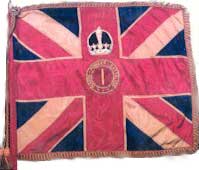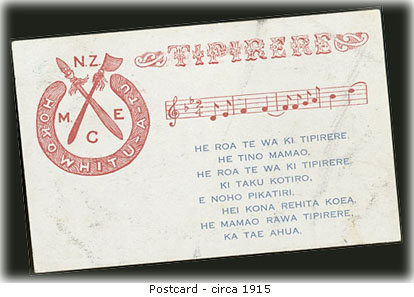Written
by Jack Judge, a London music-hall entertainer in 1912. This song was adopted
by the British Army's 7th Battalion of the Connaught Rangers Regiment. They
were mostly Irishmen, and the regiment had connections with Tipperary Town
in Ireland.
At the start
of 'The Great War' in August 1914, they took the song with them to France
where it became "the marching anthem of the battlefields of Europe."
It is still known and sung today. FULL
DETAILS
Listen to
the Tipperary tune from a phonograph cylinder played on a hand-cranked
1918 victrola REAL AUDIO
Other Maori songs of
the overseas wars
Pokarekare
Ana: popular with Maori solders in 1915-17 preparing to go to WWI.
I Runga o nga Piki: sung
in Sept 1915 to farewell the Second Maori Contingent
Te
Ope Tuatahi: 1916 recruiting song by Ngata and Tomoana.
Hoea
Ra Te Waka Nei: a heart-breaking cry for financial support for the
men in the trenches in France in 1917.
E
Pari Ra: 1918 tangi for Maori solders lost in battle during WWI.
Ho---ki,
Hoki To---nu Mai: a bereaved young wife's 1918 lament before it was
given a jazzed-up poi tune
Karangatia
Rä: sung to returning men of the Maori Battalion after WWI.
Arohaina Mai: a 1940 song of
farewell for the men of C Company (Ngati Porou). Tuini Ngati's greatest
song.
E
te Hokowhitu-a-Tü: a 1943 song remembering the Maori Battalion
who were away fighting in North Africa and Italy.
Tama
Ngäkau Märie: graveside hymn sung many, many times by men
of the 28th Maori Battalion.
Tomo/Hoki
mai e tama ma: composed in Ruatoria in 1946 to welcome home their
soldiers of the 28th Maori Battalion.
Rolling Wheels:
I haven't got this done yet. written by members
of the Maori Battalion as they rolled across Nth Africa, and added to,
as they fought their way up Italy. E-mail
me if you need it.
Blue
Smoke (Kohu Auahi): written during WWII and internationally popular
in 1948.
Te Hokowhitu a Tu
Te
Hokowhitu a Tu ('The seventy twice-told warriors of the war god'), was so
named because 140 was the favoured size of a traditional war party or taua.
The 1st
Maori contingent, "Te Hokowhitu a Tu," sailed from New Zealand in February,
1915 and fought as combat engineers and snipers in Gallipoli, (Marching
in, 477 men; marching out, 134).
There were
other Maori at Gallipoli as well, who had gone along with their Pakeha
mates in 1914 to enlist in the Hauraki, Taranaki, Auckland and Wellington
regiments.
After evacuating
from Gallipoli, the surviving fit men of the Maori contingent were combined
with the survivors of the Otago Mounted Rifles to form the NZ Pioneer
Battalion, which went to France. This was their marching song:
Ko
koe Nui Tireni,
Te kuini o te ao
Arohaina nei e au,
Ko koe tangihia
Ko koe e mihia
Ko koe te kianga pai,
Te au taku moe
Te aroha kia koe,
I te roa o te ra.
Chorus: x2
Ka whai mai ra te aroha
A huri noa te ao. |
In May 1916,
they fought at Armentieres, digging trenches and going on raiding
parties (in one raid, armed with mere). And in August 1916 they went to
the Somme, where they dug what became the famous communication trenches
'Turk Lane' and 'Fish Alley' ( or French Lane) PHOTOS.
It was dangerous work. On one day they lost 12 killed and 40 wounded.
Their
doggedness and competence when constructing these communication trenches
earned them the name of "The Diggers." This name spread to all NZers and
then to the Australians ("G'day Dig"). This is ironic, as the Australians
had a reputation for being not keen to use a pick and shovel. 
By August
1917, enough Maori reinforcements had arrived to make a complete NZ (Maori)
Pioneer Battalion of 928 men. They built combat trenches though the swamps
of Passchendale and the Ypres Salient.
At the end
of the war in November 1918, the colours of the Maori Pioneer Battalion
replaced the German Imperial Eagle over the captured town of Le Quesnoy.
2,227 Mäori
and 458 Pacific Islanders fought during WW1, 336 died on active service
and 734 were wounded.
The above
is a brief summary from Chris Pugsley's excellent book Te Hokowhitu
a Tu: The Maori Pioneer Battalion in the First World War. This book
also contains a complete list of all who were in the Battalion, and the
names and addresses of next-of-kin. It may help those compiling family
histories and whakapapa.
For more
text from this book, go to HERE
Roll of Honour
A
list of all those who died in the the New Zealand (Maori) Pioneer Battalion,
in France & Flanders 1916-1918 is HERE.
Tipirere
lyrics
The 1914
lyrics were found by Dr Chris Pugsley, author of Te Hokowhitu a Tu.
He found them on a newspaper clipping inside a copy of "Songs,
Haka and ruri for the use of the Maori Contingent" (NZ Govt Printer,
1914) held at the National Lbrary of NZ. Ruriruri were originally amorous
ditties accompanied by bawdy gestures, but seem to have been moderated
with the coming of Christianity.
The booklet
was probably compiled by Te Apirana Ngata, who was responsible for introducing
action songs into Maori culture. Te Apirana and fellow MHR Hone Heke used
to do Maori translations of popular British songs during sittings of the
House of Representitives, and the Tipirere translation was also
likely Te Api's work. (Heke died before the English original was published)
The same lyrics have since been found on a postcard from around the same
era.
Chris Pugsley's book
Christopher
Pugsley, Te Hokowhitu a Tu, the Maori Battalion in the First World War,
Reed Books, 1995 - ISBN 0 7900 0398 8
Contacting Chris
Pugsley
The flyleaf
of the book gives his whereabouts as Wellington, but the Chris Pugsley in
the Wellington phone book is, in fact, another person who, in an extremely
courteous and patient manner, tells about 40 callers a year that Chris-the-military-historian
is lecturing at Sandhurst in England and can be contacted here.
Other
Maori Songs - Main Song List - Home
1914 version published on web April 2002. Living version of the song received
in Feb 2005

